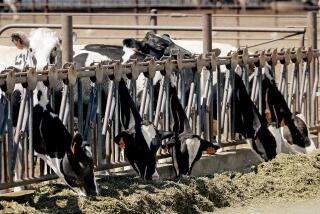California farmers: How the state feeds a nation
You know how the rest of the country likes to make fun of California, but how much would they miss us if we were gone? You can certainly bet the weeping and wailing would be off the charts at dinner time.
According to the latest statistics compiled by the California Department of Food and Agriculture, the state produces almost half of all the fruits, nuts and vegetables grown in the country, as well as a whopping share of the livestock and dairy.
All told, the state’s farms earned almost $45 billion in 2012, the last year for which statistics are available – that’s more than 11% of the nation’s total. The biggest winners include milk, which earned $6.9 billion; grapes ($4.5 billion); almonds ($4.3 billion); strawberries ($1.9 billion); lettuce ($1.5 billion); walnuts ($1.3 billion); and tomatoes ($1.2 billion).
MORE: Behold the beet - plus 12 recipes
Indeed, if California’s ego needed any more plumping, there are 66 food crops in which we lead the nation, including growing virtually all of the almonds, artichokes, dates, figs, raisins, kiwifruit, olives, clingstone peaches, pistachios, prunes, pomegranates, sweet rice and walnuts.
But while the state’s agricultural dominance is a matter of long standing, there are interesting shifts going on beneath the bottom line. For example, the olive industry, which has been moribund for so long, saw an almost 150% increase in earnings. Tangerines continued to grow in popularity, increasing more than 75%. And table grapes, which have long been a California staple, increased in value more than 40% in 2012.
There were losers too. It continues to be a tough time to grow kiwis and cauliflower; both are down more than 25%.
MORE: A rich time for navel oranges - plus 10 recipes
In general, though, this has been a very good time to be a farmer in California. Net farm income nearly doubled between 2008 and 2012, almost entirely because of increases in earnings, particularly for food crops.
There are other fascinating tidbits scattered through the report. For example, while there are plenty of large farms in California – 8,700 earned more than $500,000 in 2012 – they are vastly outnumbered by smaller farms – a little more than 61,000 earned less than $100,000.
And the size of the average California farm actually has shrunk over the last decade – from 347 acres in 2002 to 317 in 2012. That’s much smaller than the average farm in the U.S., which is 434 acres.
It’s important to note that these statistics do not include the last drought-stricken year, which presumably will have some effect.
Still, they’d certainly miss us if we were gone.
ALSO:
Are $1,000 Napa Cabs on the way?
The fresh face of new Irish cooking
Can it be Parmesan if it’s not from Parma?
More to Read
Eat your way across L.A.
Get our weekly Tasting Notes newsletter for reviews, news and more.
You may occasionally receive promotional content from the Los Angeles Times.











